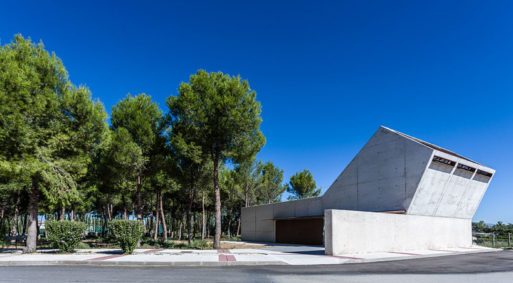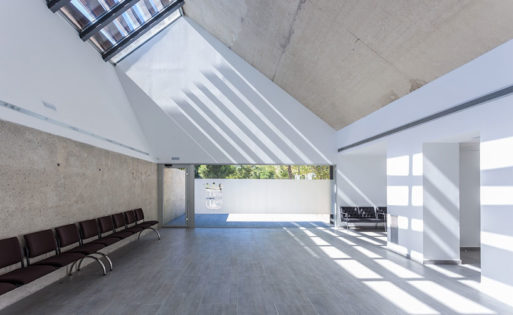
Credit: designboom.com
Photo by Diaporama
When you think of a death-centered art project, you probably don’t picture a massive concrete building. Yet this is exactly what architect Juan Carlos Salas created when he designed a unique tanatorium (literally “mortuary”) located on the outskirts of Zaragoza, Spain.
On the surface, the tantorium is an unassuming white concrete building with no intricate carvings or design details other than a rectangular vault that juts out at an angle on one side. But this impression changes when you take a closer look at the hidden details inside.
Once inside of the space, you immediately understand its strange, jutting shape. The windows cut into the top of the high, angled ceiling are at the perfect angle to capture the movement of the sun throughout the day. Long, narrow window panes break up the sunlight, creating a series of lines throughout the interior, which create “an atmosphere which visually evokes the feeling of time passing,” Salas explains. As the sun moves through the sky, the angle of the lines changes, moving along the floor until the sun begins to set. It’s a mirror for life in this sense; you observe the slow passage of time until the light is completely extinguished, as life is extinguished in death.

Credit: designboom.com
Photo by Diaporama
The inside of the tantorium hall is spartan, with only a few chairs lining the walls. The open floor plan allows families to gather and take in the entirety of the space, and the lack of decoration allows each person to bring their own personality into the room where funerals and memorial services are held.
With the tantorium design, Salas finds a perfect balance between aesthetic and neutrality. The space is simple and sparse, but the entry of the sunlight makes it feel warm and welcoming. The location of the building also invokes warmth and comfort. Salas insisted that it be built next to a small oasis of trees. This nod to nature clashes with the cold, man-made concrete, yet somehow brings more beauty to the scene.
In the past, crematoriums and funeral parlors were all function and little art. But as more people turn to cremation and other rituals that require large functional rooms, we are beginning to see art and function come together in beautiful and unique ways. Like Juan Carlos Salas, artists are embracing the concept of death rather than hiding it away.

 The Tanatorium Sheds Literal Sunlight on Grieving Families
The Tanatorium Sheds Literal Sunlight on Grieving Families


 Our Monthly Tip: Make an “In Case of Death” File to Ease Loved One’s Grief
Our Monthly Tip: Make an “In Case of Death” File to Ease Loved One’s Grief
 Passing of Beloved Comedian Births a New Comedy Festival
Passing of Beloved Comedian Births a New Comedy Festival















